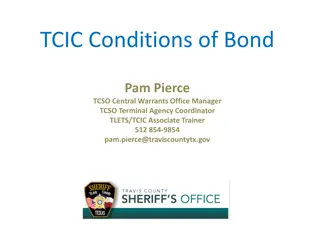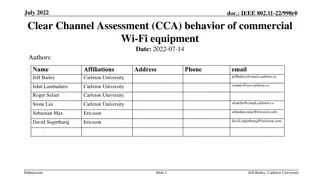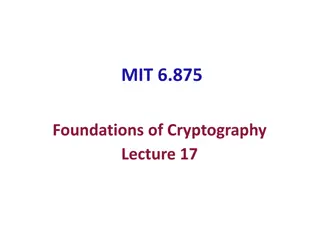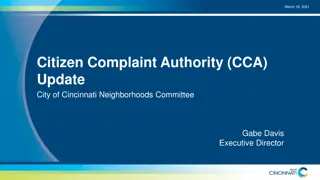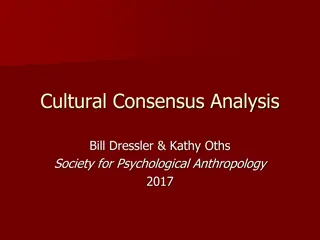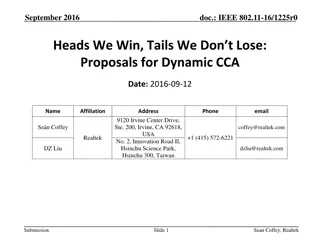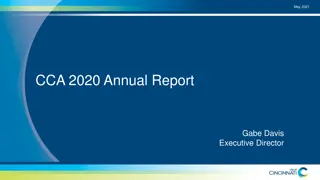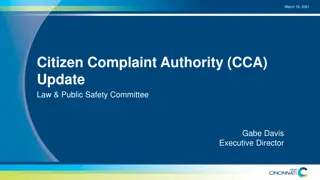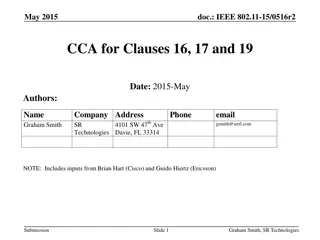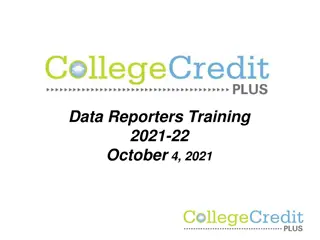Understanding Complex Computing Problem (CCP) and Complex Computing Activity (CCA)
Dr. Saman Hina, along with Dr. Farrukh Arif and Dr. Maria Waqas, presents information on Complex Computing Problem (CCP) - a problem involving technical, computing, and other issues with no obvious solution, requiring deep knowledge and analytical thinking. CCP is evaluated through predefined rubrics, created by course teachers, and shared with students during assignment. The evaluation criteria cover various attributes related to complex problem-solving. Special thanks to Dr. Farrukh Arif and Dr. Maria Waqas for providing CCP examples and rubrics.
Download Presentation

Please find below an Image/Link to download the presentation.
The content on the website is provided AS IS for your information and personal use only. It may not be sold, licensed, or shared on other websites without obtaining consent from the author. Download presentation by click this link. If you encounter any issues during the download, it is possible that the publisher has removed the file from their server.
E N D
Presentation Transcript
Understanding Complex Computing Problem(CCP) & Complex Computing Activity (CCA) Presented by: Dr Saman Hina (OBE Coordinator)
Acknowledgements Dr. Farrukh Arif (OBE focal person NEDUET) Dr. Maria Waqas (COBEC member) For providing CCP example problems and Rubrics
What is CCP? A Complex Computing Problem is a computing problem having some or all of the following characteristics: Involves wide-ranging or conflicting technical, computing, and other issues Has no obvious solution, and requires conceptual thinking and innovative analysis to formulate suitable abstract models A solution requires the use of in-depth computing or domain knowledge and an analytical approach that is based on well-founded principles Involves infrequently-encountered issues Is outside problems encompassed by standards and standard practice for professional computing. Involves diverse groups of stakeholders with widely varying needs Has significant consequences in a range of contexts Is a high-level problem possibly including many component parts or sub-problems Identification of a requirement or the cause of a problem is ill defined or unknown
CCP/CCA Evaluation CCP shall be evaluated through pre-defined rubrics, and not by any other means These rubrics are created by the course teacher depending upon the nature of the problem The communicated to the students at the time of assignment of the complex computing problem. rubric shall be Evidence of exposure to complex computing problem provided in the respective Course File, including statement of CCA and rubric based evaluation. shall be The criteria defined in the rubric shall cover the attributes selected for the activity from Table 1 and Table 2.
Table 1 Range of Complex Problem Solving Attribute Complex Problem Preamble A Complex Computing Problem is a computing problem having some or all of the following characteristics: Range of conflicting requirements Involves wide-ranging or conflicting technical, computing, and other issues Depth of analysis required Has no obvious solution, and requires conceptual thinking and innovative analysis to formulate suitable abstract models Depth of knowledge required A solution requires the use of in-depth computing or domain knowledge and an analytical approach that is based on well- founded principles Familiarity of issues Involves infrequently encountered issues Level of Problem is outside problems encompassed by standards and standard practice for professional computing
Table 1 Range of Complex Problem Solving Attribute Complex Problem Extent of stakeholder involvement and level of conflicting requirements Involves diverse groups of stakeholders with widely varying needs Consequences Has significant consequences in a range of contexts Interdependence Is a high-level problem possibly including many component parts or sub-problems Depth of knowledge required A solution requires the use of in-depth computing or domain knowledge and an analytical approach that is based on well- founded principles Identification of a requirement or the cause of a problem is ill defined or unknown Requirement identification
What is CCA? A Complex Computing Activity is a computing activity or project that has some or all of the following characteristics: Involves the use of diverse resources Requires resolution of significant problems arising from interactions among wide- ranging or conflicting technical, computing, contextual, or other issues Involves creative use of knowledge of computing or domain principles in novel ways Has significant consequences in a range of contexts Can extend beyond previous experiences by applying principles-based approaches
Problem-based Learning Problem-based learning is a means of conducting a Complex Computing Activity
Table 2 Range of Complex Computing Activities Attribute Complex Problem Preamble A Complex Computing Activity is a computing activity or project that has some or all of the following characteristics: Range of resources (people, money, equipment, materials, information, and technologies) Involves the use of diverse resources Level of interactions Requires resolution of significant problems arising from interactions among wide-ranging or conflicting technical, computing, contextual, or other issues Innovation Involves creative use of knowledge of computing or domain principles in novel ways Consequences to society and the environment Familiarity Has significant consequences in a range of context Can extend beyond previous experiences by applying principles-based approaches
Designing CCP and PBL CCPs/ PBLs shall be properly defined. Description may include at- least the following: i. Problem description ii. Constraints/ Assumptions iii. Identification of areas where use of computational/ modern tool is required. iv. Expected outcomes
Sample Question Order management consists of several critical business processes, including order, shipment, and invoice processing. These processes spawn important business metrics, such as sales volume and invoice revenue, that are key performance indicators for any organization that sells products or services to others. Problem Description ABC company manages order management of Watches and Jewelry. The company manages to take orders in their shops and also offer customized products with preferable features; such as colors of straps and chains of watches, and addition/removal in jewelry designs. This company now aims to shift their store/shop business to online system. Constraints/Assumptions This online system will have display of products for these two categories. In addition to that, customer can add products in shopping cart and can make payment using three modes; Credit card, EasyPaisa, Cash on Delivery. Area identification DESIGN and DEVELOP best design for this system by adding appropriate functionalities. Expected outcomes 1. Object-oriented design using UML Class diagram with complete notations with proper naming conventions.2. Implementation of the object oriented design of the given problem. 3.Clearly drafted assumptions (if any)
Sample Question Problem Description Children often play the game of rock, paper, and scissors. This game has two players, each of whom chooses one of the three objects: rock, paper, or scissors. The game is played according to the following rules: If both players choose the same object, this play is a tie. If one player chooses rock and the other chooses scissors, the player choosing the rock wins this play because the rock breaks the scissors. If one player chooses rock and the other chooses paper, the player choosing the paper wins this play because the paper covers the rock. If one player chooses scissors and the other chooses paper, the player choosing the scissors wins this play because the scissors cut the paper. Write an interactive program in C that allows two people to play this game. Area identification Input: Two inputs: The users' responses when asked to play the game. The players' choices. Output: The players' choices and the winner of each play. After the game is over, the total number of plays and the number of times that each player won should be output as well. Expected outcomes Assumptions: Each player enters R or r for Rock, P or p for Paper, or S or s for Scissors. While the first player enters a choice, the second player looks elsewhere Constraints/Assumptions
Sample Deliverables/Outcomes of PBL Complete C source file A report containing the details of various concepts and constructs used in the project; Pseudocode of the program. Flowchart of the program.
Reflection Exercise Draft CCP or CCA for your respective courses (group work is encouraged for common courses). Share it with your peers for learning.


